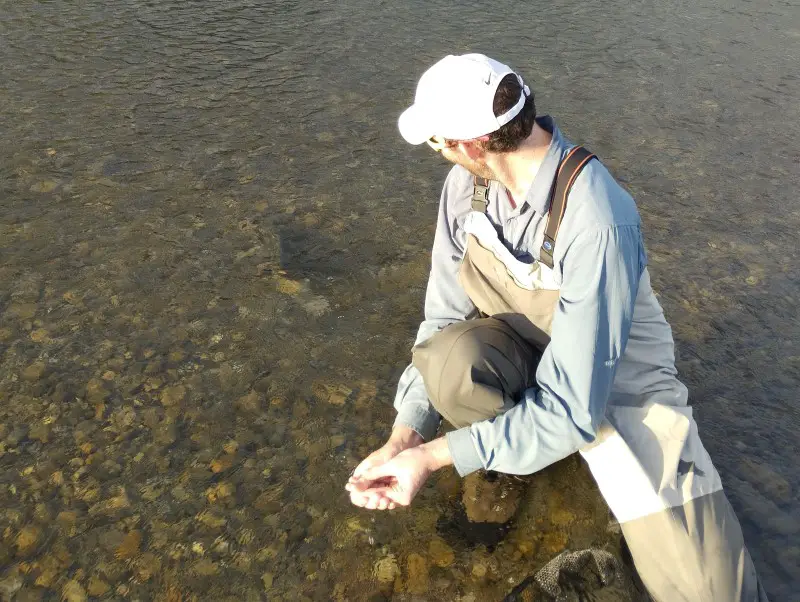In one experiment published in the Journal of Fish and Wildlife Management, it was found that wild rainbow and Westslope Cutthroat trout had an average speed of 0.84m/s (or 1.97mph), while the fastest recorded speed was 6 miles per hour for Rainbow Trout and just under 8mph for the Westslope Cutthroats.
Although, in a burst, rainbow trout have been reported to reach speeds up to 18mph. I have also seen, several online publications quote a speed of 32mph for Steelheads but I can not find the original source for that figure.
The top maximum speed of trout is ambiguous, but I think we can all agree they have some powerful acceleration.
So, how does this knowledge help us catch more trout? Well, in most ways it does not. But it does show that trout, when not in a state of panic swim at quite a leisurely pace.
This also helps to justify the belief that trout are much more likely to strike at a slower retrieved lure rather than a quick moving one. They do not enjoy exhausting energy to go on a high-speed chase.
How quickly can a trout empty a spinning reel?
Just for fun, it is possible to calculate how quickly a trout can spool a fisherman. Assuming it decides to swim away at a constant speed. For the calculations, I will assume the reel holds 110 yards of 6lb line, 100 of which is still on the reel after casting.
Fortunately, trout rarely go on such powerful runs, the drag on the reel, combined with the resistance of the line dragging through the water quickly tires them, causing them to slow or even change direction. I have never had a fish come even close to spooling me.
How fast do rainbow trout swim when migrating upstream?
One study (link), tracked Rainbow trout on their respawn migration up the Tongariro river (New Zealand). It took rainbow trout on their spawning run 62 days to travel 20km (12 miles) upriver. That is only 321m or 350 yards per day. They certainly were not in any hurry. I tried to find research on a North American river but had no success.
Not all Rainbows were that slow, one extra motivated Rainbow traveled 26km in just 16 days, that is a mile every day. The researchers also found that freshes and increased river flows motivated the trout to move.
The Rainbows did most of their upstream migration between 16:00 and 20:00, and no fish moved between midnight and 4 am. So it seems, they covered most of the distance in the evening.
Many of the trout also rested for several weeks at the mouth of the spawning tributary before deciding to enter.
How fast and far do brown trout move upstream to spawn?
I was able to find one telemetry study (link) of Brown trout migrating up the River Meuse in Belgium. It is one of the major rivers in Europe.
Before the 1st of October, the trout migrated only slowly. Never covering more than 300m on any given day. This movement was put down to displacement from floods and non-migratory feeding patterns.
From October 7, to the 15 of November the monitored brown trout started their migration upstream where they covered between 5.6 to 22.95km (3.5-14 miles) to reach their spawning grounds.
The average speed varied greatly. At the start of the migration, they moved quite quickly covering over 5km(3 miles) per night.
They progressively slowed the closer they got to their spawning grounds. This slowing was probably due to the colder water temperatures.
Brown trout movement within a Michigan stream
One study (link) decided to telemetry track large Brown trout (400mm+) for an entire year and they had some interesting findings. Although, they did not track their speed of movement.
In that year, individual trout moved, both upstream and downstream covering distances varying between 370m to 33,420m (400yds – 21.7 miles) . So some of the fish were homebodies while others went exploring.
During the winter, 5 of the 6 fish swam 10km (6 miles) upstream to much slower deeper water where they took up residence for the colder months. That part of the river was widely considered too warm for trout during the summer.
In their summer range, the trout did not stick to one home site, but they moved between several sites every few days. The average distance between the home sites was 386m (422yds)
How fast do steelhead swim when migrating upstream?
Migrating fish can move through a waterway at very varying speeds. One study in the Snake River found Steelheads took a median time of 32 to 47 days to travel 277 miles upstream. But, the fastest swimming Steelhead covered that distance in only 9 days, while the slowest took 160 days.
This means, that the average steelhead was swimming just under 7 miles every day. While the fastest covered 30 miles, and the slowest went a leisurely 1.7 miles per day. If you are trying to track and follow migrating fish, I think it is safe to assume the shoals will move approximately 7 miles every day.
They also found that water temperature had a large influence on travel speed with most migrating occurring when the water temperature was between 65°F -72°F. When the water temperatures are warmer, the steelheads slowed down, likely seeking shelter in the deepest pools. When the temperatures were cooler they covered many miles. So during warm summers, steelheads will take longer to cover the same distance.

